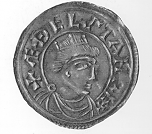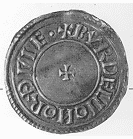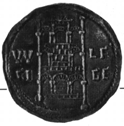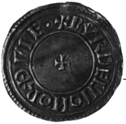How do you think a blood-feud could be stopped without more killing?
Sometimes a feud could be settled without any more killing if the killer or his tribe agreed to pay money to the dead man's family. This money was called 'wer-gild' or 'man-price'.
The price for killing a lord or king was highest. The wer-gild for a thane (nobleman) was less, and lower still for a free farmer. Lowest of all was the wer-gild for a slave.
In the end this kind of payment became part of the law. You had to pay money if you wounded somebody too. Under the Anglo-Saxon King Alfred the price was thirty shillings for an ear cut off, sixty shillings for a nose, nine for a little finger and twenty for a big toe.
Here are some coins from the reign of King Athelstan:
The most common Anglo-Saxon coins were the sceat, the penig (penny) and the styca. The ones in the picture are silver penigs.
It took
240 penigs to make a pound,
about 55 penigs to make a shilling,
and 30 penigs to make a mark.




